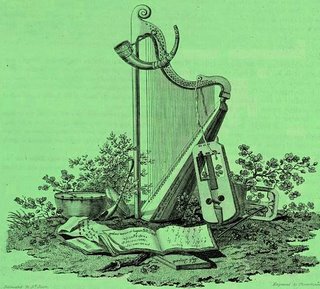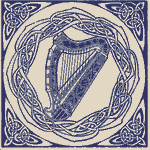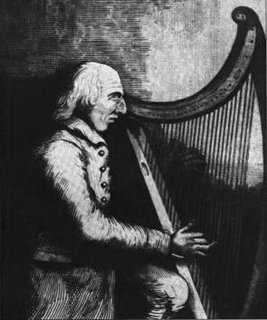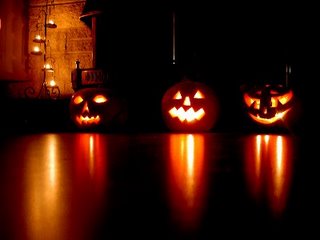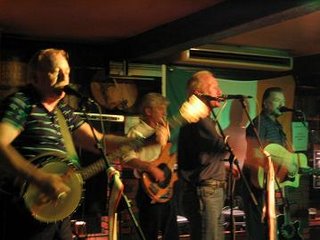 Getting It Right
Getting It Right
What exactly is authentic Irish music?By Earle Hitchner, The Irish Echowww.irishecho.comehitchner@irishecho.com
"Get your genuine facsimile. Don't be fooled by the real thing." A rock critic who's a friend of mine laughed as he said that in reaction to a new rock album purporting to be authentic in its genre.
That made me wonder: what is authentic Irish music?
Those who admire the Clancy Brothers and the Dubliners might sneer at the notion of ascribing Irish authenticity to "Toora Loora Loora," "When Irish Eyes Are Smiling," and "MacNamara's Band," staples of early 20th century Irish Americana, or to Bing Crosby, who had popular hits with those songs.
Waterford-born, Massachusetts resident Robbie O'Connell, who toured and recorded with the Clancy Brothers (his uncles), wrote "You're Not Irish" as a response to his first foray as an Irish singer in America. The song contains this chorus: "You're not Irish, you can't be Irish, you don't know 'Danny Boy' / Or 'Toora Loora Loora' or even 'Irish Eyes' / You've got a hell of a nerve to say you came from Ireland / So cut out all the nonsense and sing 'MacNamara's Band.'"
Those who admire ceili bands, Planxty, and the Bothy Band might scorn the notion of ascribing Irish authenticity to "The Unicorn Song," a huge hit for the Irish Rovers in 1968 that was composed by cartoonist and well-known children's book author Shel Silverstein.
Song provenance aside, some staunch traditionalists might turn ashen at the notion of hearing yet another rendition of "Whiskey, You're the Devil," "Leaving of Liverpool," and "Wild Colonial Boy," popular staples in the 1950s and 1960s that are often slotted loosely in the come-all-ye bailiwick of balladry.
Those who admire many of the previously mentioned songs might blanch at the notion of ascribing Irish authenticity to "The Sick Bed of Cuchulainn," "Bottle of Smoke," and "Fairytale of New York," written or co-written by Shane MacGowan and recorded by the Pogues.
Those who admire the Pogues might recoil from the rock-like acoustic rhythm of the Bothy Band a decade earlier or the anthemic rock purveyed by U2 a decade later.
Rebel songs from the Wolfe Tones and music from Irish showbands have their own devotees (patriotic, fun) and detractors (jingoistic, kitsch).
When I visited the southern New Jersey shore earlier this month, I was greeted with the tagline "authentic Irish music" in an ad for what was a mediocre rock band in a bar where only the $3 Coors Light special went down smoothly.
The ad for an Atlantic City casino pub self-described as "the real flavour of Ireland" sported nubile women in short skirts shaking their booties under this quote attributed to Eamon De Valera: "Comely maidens dancing at the crossroads." Uh-huh.
At another Atlantic City Irish bar-restaurant, a musician performing on "Celtic Sunday" made this remark to a reporter from the Atlantic City Weekly newspaper: "There's a difference between what most Americans perceive as Irish music and what really is Irish music. I think many Americans got exposed to authentic Irish sounds for the first time with the arrival of 'Riverdance.'"
Are the soprano sax, gadulka, kaval, tom-toms, dumbek, cantaor, and palmas heard in "Riverdance" among these "authentic Irish sounds"?
Nearly a decade ago, I suffered my only abject case of in-print embarrassment at the Irish Echo over a lengthy profile/interview article I wrote about Gaelic Storm. You'll recall this Santa Monica-based pub group was cast as the party band in the steerage scene of the blockbuster movie "Titanic" and had been hired for the film precisely because they were bad. The title I submitted for my article was the admittedly prosaic "Irish Dance Band on the 'Titanic.'" I did everything I could not to inject my own opinion of Gaelic Storm but to let others describe them. The title that actually ran in large bold type across my two-page article was this: "Hey, You Guys Really Stink." I was mortified, and Gaelic Storm was livid. Obviously that newspaper clip didn't make it into the band's media kit, nor is it in my own portfolio.
Are the hard-touring (more than 125 dates a year), incontestably popular Gaelic Storm, who have now released six commercially successful albums in the wake of "Titanic," providing authentic Irish music, no matter how clumsily performed? I'd argue, after taking a long, deep breath and donning a flameproof suit, yes.
In the first act of Noel Coward's play "Private Lives," a character utters this line: "Strange how potent cheap music is." I suppose we all harbor deep, dark secret favorites from overtly commercial and arguably superficial or sappy "cheap music." Let me be the first to come clean: I still enjoy some of John Klemmer's Echoplex-inflected sax music, even though I can't defend it on jazz aesthetic grounds. The late Johnny Cunningham, founding fiddler of Silly Wizard and Relativity, once admitted to me how profoundly Foreigner's "I Want to Know What Love Is," a No. 1 pop hit in 1984, affected him. Stunned, I understood.
Bludgeoned over the years by countless bad pub singers, Scottish-born, Australia-naturalized Eric Bogle's "And the Band Played Waltzing Matilda" remains a brilliant, vivid, vital narrative song. It always gets to me, including the Pogues' rendition on their 1985 album "Rum Sodomy & the Lash." Some critics found that version too plodding. To me, that's what makes it interesting. The weariness conveyed in MacGowan's voice mirrors the weariness conveyed in the lyrics. Whether intended or not, that is part of its impact for me.
The Pogues, of course, were a lightning rod for trad and punk-rock critics. A number of punk-rock critics thought the Pogues were the most important band during the 1980s. A number of trad critics were mystified at how punk-rock critics with little or no knowledge of Irish trad could champion much of the band's instrumental melee.
In rock, attitude trumps aptitude, and the Pogues had attitude to spare. By a landslide, I'd take vintage Pogues then over Gaelic Storm now -- and not just because of Shane MacGowan's powerful songwriting. Despite the instrumental shortcomings of the Pogues, the sum was far greater than the parts, and critic Andy Whitman recently praised the band's "belligerent caterwaul" that helped to prove "Celtic Punk was not an oxymoron."
Whitman, however, strayed off the path of plausible argument with this silly comment: "As a general rule, fans of Celtic music are not a demonstrative lot." That's rubbish. Ask Altan, Lunasa, Danu, Solas, Dervish, and Christy Moore fans, who at times can make metalheads, Parrot Heads, and E Streeters sound like a tame crowd.
But back to the overarching question: what is authentic Irish music? It's a moving target, hard to hit definitively, and that's not a critical copout. Geography is less significant in this age when a profusion of home recordings and Internet access enables people around the world to develop their avocational or vocational interest in Irish music. Fiddlers Dana Lyn and Patrick Ourceau are just two examples of Irish traditional musicians who neither are Irish nor have a strong Irish trad childhood to draw on. They are among a growing global population of Irish trad music autodidacts: nonnative individuals who fall in love with the music and learn to perform it as intensely as the son or daughter of a fiddle master in Miltown Malbay or Sliabh Luachra.
As a critic, I've been described by fusionists as too indulgent of hard-core trad performers and by hard-core trad performers as too indulgent of fusionists. Fans of the Afro Celts, Kila, Frankie Gavin, and John Doyle have all wanted my scalp at one time or another.
Yet I've always believed that tradition cannot survive without innovation. "The Bucks of Oranmore" and "The Morning Dew" reels, for example, were new and fresh when first heard. Long since detached from their composers, these two traditional tunes flourished because they passed the test of posterity, separating the durably beautiful from the merely fashionable.
Just posing the question -- what is authentic Irish music? -- is itself part of a continuous cultural winnowing. For the survival of the fittest Irish music, chaff should be chucked. It's a process that forces all of us to re-examine our most cherished criteria in the spirit of intelligent accommodation rather than weak-kneed compromise. Cape Breton tunes are seeping into the Irish repertoire, and vice versa: it's not a matter of why but why not? Why shouldn't "Brenda Stubbert's" reel, composed by Jerry Holland, sit comfortably beside "Breen's Reel," an Irish trad tune, in the fourth track of Altan's "The Red Crow" album?
There is no such thing as right or wrong Irish music. Irish music is well done or badly done. That is all. (Apologies to Dublin-born Oscar Wilde for adapting lines from "The Picture of Dorian Gray.")
Authentic Irish music? Let's just say I'll be tucking the first Bothy Band album, the first Moving Hearts album, the first Planxty album, the Pogues' "If I Should Fall From Grace With God" album, U2's "Joshua Tree" album, and the Tulla Ceili Band's "Echoes of Erin" album into my desert-island kit bag.
And if there's room, I'll sneak in John Klemmer's "Touch" album. 
This story appeared in the issue of Irish Echo August 23 - 29, 2006







